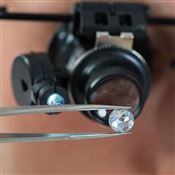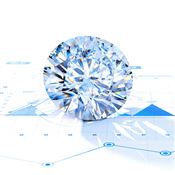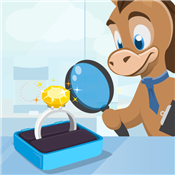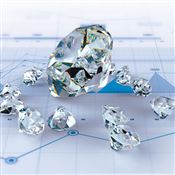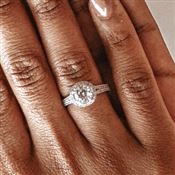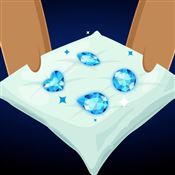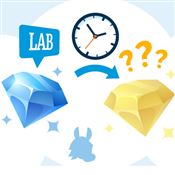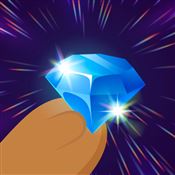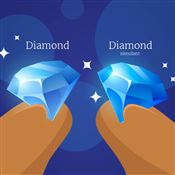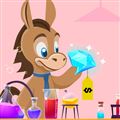Diamond Color Chart
What is the best color for diamonds? And how much does color affect the price? Read on for our diamond color chart and the rule of thumb for diamond buying.
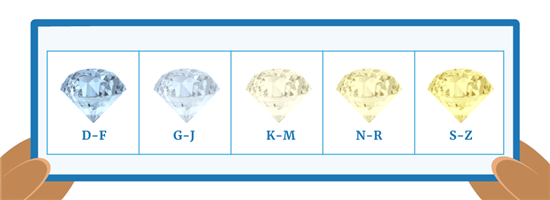 |
What Is Diamond Color?
In gem jargon, color refers to how clear or yellow a diamond is. Truly colorless diamonds are the most prized, but they're actually super rare. In reality, most diamonds come with a slight yellowish tint caused by nitrogen.
To measure diamond color, labs use the Gemological Institute of America's (GIA) diamond color grading scale. Here, diamonds are given a grade from D (colorless) to Z (light yellow/brown). Between them are stones with yellow tints that range from near colorless to very visible.
While the scale goes all the way to Z, diamonds used in engagement rings usually fall within the D-K range. Anything above K is usually considered too yellow.
You won't usually notice a huge visible difference between different color grades. But the gulf in price is huge. That's why you can often find the best value in near colorless stones, especially H-J.
You'll understand this better when you see the diamond color chart.
Before the GIA made its scale, other gem color systems were in place. This included scales that used letters A, B, and C to mark quality. To avoid confusing buyers, the GIA started with D. It's not a letter you'd usually equate with top quality and associate with other scales.
Diamond Color Chart
The GIA divides its color scale into 5 groups:
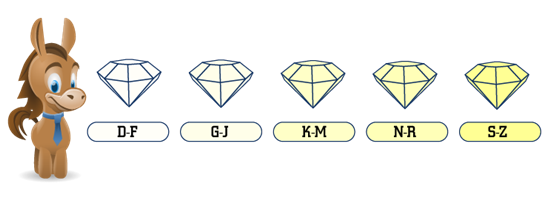 |
| Diamond Color Scale © CreditDonkey |
- D, E, F (Colorless)
These diamonds are super rare. D is absolutely colorless. E and F are considered colorless because only an expert gemologist can detect tiny, tiny traces of color. There is no visible difference among these diamonds.Colorless diamonds come at a much higher price. If you like knowing you've got the best, you may not mind paying the premium, as long as you understand that it's not necessary.
- G, H, I, J (Near Colorless)
A slight yellow tint can be detected by an expert gemologist. However, the average person most likely will not be able to see it in G, H, and I diamonds. They look just as white as colorless diamonds.At the J grade, the tint becomes a bit more apparent when compared to a diamond of higher color grade. But they offer great value, especially if you prefer a warmer look to your jewelry.
- K, L, M (Faint)
A yellow color is more noticeable at this point, even without comparing to another diamond. Usually, online retailers don't sell diamonds for engagement rings less than a K. But K diamonds are beautiful when set in yellow or rose gold. - N–R (Very Light)
Very noticeable yellow tint and looks like a poor quality diamond, even to an untrained eye. - S–Z (Light)
Color at this range can start to have a brown tint. Needless to say, there is very little demand for these.
Does Diamond Color Matter?
Many people think that a whiter diamond will appear more brilliant. But this is NOT true.
Color refers to the yellow tint commonly seen in white diamonds. It has absolutely nothing to do with how shiny or sparkly a diamond is. Cut is the factor that affects brilliance, so that should be of highest importance.
Most people cannot tell the difference between colorless and near colorless diamonds. But the price difference is huge. So put your money instead towards a better cut or bigger stone or fancier setting (things that people CAN see).
That said, color still contributes to the overall beauty of ring. So let's take a detailed look at diamond color and what to look for.
- D–G diamonds are priced at a premium and are not necessary. But should you choose one, it should only be set in platinum or white gold.
- H–I diamonds are the best value for platinum and white gold rings.
- J–K diamonds are most affordable and look great set in yellow gold or rose gold rings.
Diamond Color and Price
The difference in price as you go up and down color grades is truly staggering. The price difference between H color grade and D could jump over $1,000. And there is no visible difference to the casual observer. So don't waste your money just to buy something that looks better on a piece of paper.
For the best value for your money, we recommend H color grade. H is commonly thought of as the tipping point between colorless diamonds and diamonds with a slightly noticeable tint. It appears perfectly white to most people. H is a safe choice for any diamond shape and color metal.
Diamond Color and Setting
The color of your setting makes a big impact on how white the diamond appears too.
A diamond will naturally pick up the color of its surroundings (in this case, the band). If set in a yellow gold band, even the most colorless, iciest of diamonds will take on a warmer, yellowish tint. So it'll be a waste of money to spend the premium on a colorless stone.
Here are some very important rules to go by:
- D–G diamonds should only be set in platinum or white gold in order to appreciate the icy color.
- H–I diamonds are great value and can be set in any band color.
- J–K diamonds look great in yellow/rose gold bands. They will appear yellow against platinum/white gold.
Fold a pure white business card in half and place the diamond in the crease. Look at it away from the spotlights. If you see any yellow at all, it will also appear yellow when set in white gold or platinum. This diamond is most likely at best a J or K.
Diamond Color and Shapes
The shape of your diamond also plays a role. Some shapes hide color better. And some shapes are more likely to display the yellow tint, so it's more important to choose a higher color grade.
Here's the general rule of thumb:
- Round
Most brilliant and, therefore, best at masking color. Focus on getting the best cut instead. With an excellent cut, you can get away with a diamond lower in color. - Princess, Cushion, and Radiant
These shapes show more color than round. We recommend no less than H or I for a colorless look. - Oval, Pear, and Marquise
These diamonds have pointed ends that trap color. Go no less than H for platinum/white gold rings, and J for yellow/rose gold rings. - Emerald and Asscher
These diamonds have a large open table straight into the depth of the stone. Thus, they display color more. Go no less than H for platinum/white gold rings, and J for yellow/rose gold rings.
Diamond Color and Fluorescence
Fluorescence is another factor that affects diamond color, but often in a good way.
Fluorescence is when a diamond shows a soft glow under UV light (usually blue). This is caused by certain minerals in the diamond. This effect is totally natural, appearing in one-third of all diamonds.
Here's how it can help: Fluorescence improves the color of diamonds with lower color grades (H and below). A medium-to-strong blue fluorescence counteracts the slight yellow tint and makes it look whiter—usually by one whole color grade.
This means you can save money by buying a lower-grade diamond with fluorescence, and have it appear whiter.
Fancy Colored Diamond
Diamonds can fall outside the D-Z color scale and become fancy-colored. There are two scenarios: one, they have very intense yellow or brown hues that exceed the Z color grade. Two, they have colors other than yellow and brown, like gorgeous reds, pinks, and blues.
Fancy-colored diamonds are super rare, appearing in only 1 out of 10,000 diamonds. Some colors are harder to come by, with the rarest being red diamonds. They're so rare that the GIA wasn't able to find a single red diamond for 30 years.
You'll be surprised how much fancy color diamonds cost. And yep, we have their extreme rarity to blame.
Final Tips About Color
- Always focus on cut first
The cut of the diamond (proportion, symmetry, and polish) makes the biggest impact on how bright, and therefore "white," the diamond appears. A lower color but well-cut diamond will appear brighter than a poorly cut, colorless diamond. So we always recommend putting your money towards a better cut than a higher color grade. - Matching side stones
If your ring setting has side stones (like the three-stone style), it's important that the center stone at least matches the color of the side stones. You do NOT want your main stone to appear yellow. Usually, sites like James Allen will tell you the color of the side stones.Single stone settings (like solitaire) don't have to worry about this.
- Larger stones
Larger diamonds will show more color, since the facets are larger. If you're purchasing a large diamond 2 carats or over, you'll also want to upgrade the color a grade higher than our recommendations.
Bottom Line
Diamond color is not as important, but it does still affect the overall beauty of the ring. The average person can't tell the difference between colorless and near colorless diamonds, so there's no point splurging on a feature you can't see.
If you're not sure, H is a safe choice for any shape and band color. It offers great value in terms of price and beauty. For yellow gold and rose gold rings, you can save even more money by going down to J or K.
First think about what kind of setting and diamond shape you want. Then you can follow our guidelines to choose the best color for your ring.
Write to Anna G at feedback@creditdonkey.com. Follow us on Twitter and Facebook for our latest posts.
Note: This website is made possible through financial relationships with some of the products and services mentioned on this site. We may receive compensation if you shop through links in our content. You do not have to use our links, but you help support CreditDonkey if you do.
|
|
| ||||||
|
|
|
